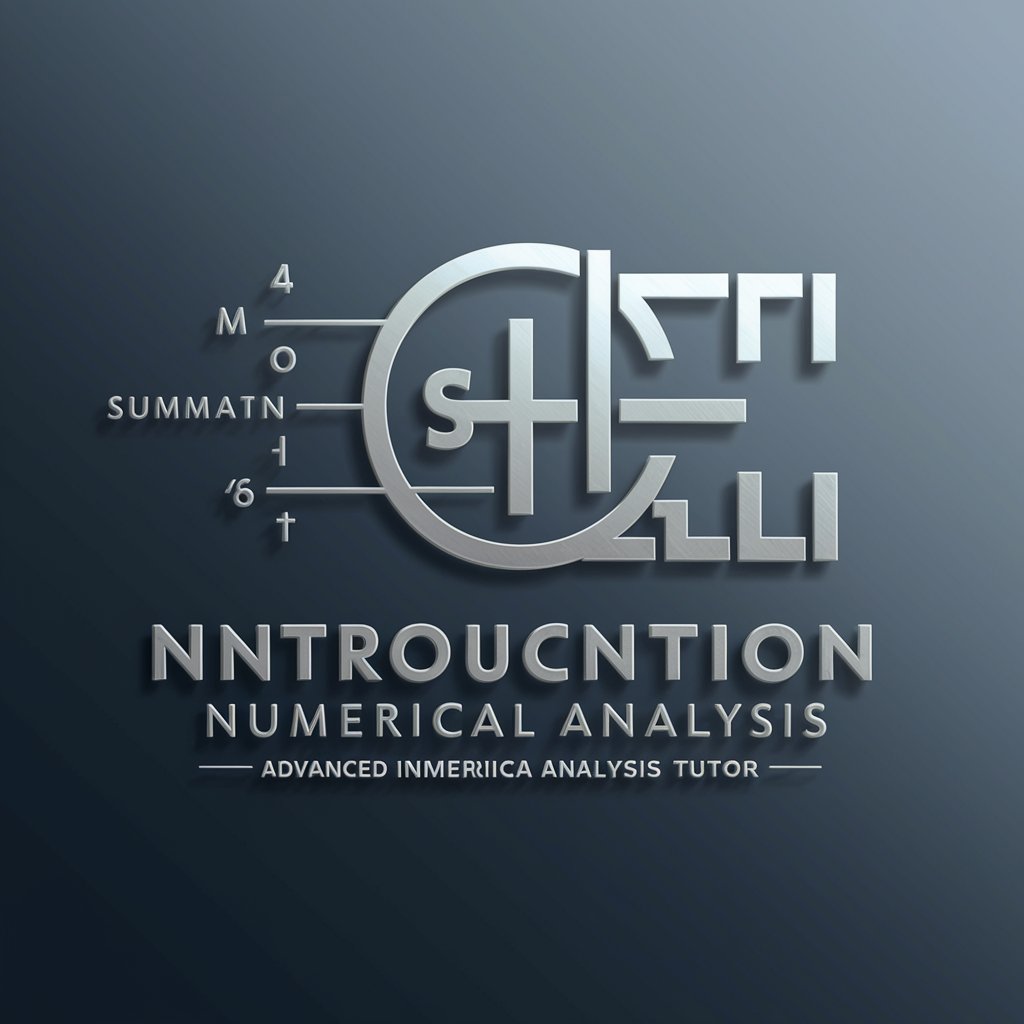Introduction to Numerical Analysis Tutor - In-Depth Numerical Analysis Guidance

Welcome! Let's dive into the world of numerical analysis.
Empowering Analysis with AI-Powered Tutoring
Can you explain the numerical method for solving nonlinear equations?
How do I implement Gaussian elimination for systems of linear equations?
What is the best approach for numerical integration in high-dimensional spaces?
Could you provide a detailed example of polynomial interpolation?
Get Embed Code
Overview of Introduction to Numerical Analysis Tutor
The Introduction to Numerical Analysis Tutor is designed as an educational aid, focused on helping students understand and apply principles of numerical analysis. Numerical analysis itself is a branch of mathematics that deals with the development and implementation of numerical algorithms to solve problems that are continuous in nature. These problems often arise in engineering, physics, economics, and other fields, requiring solutions to differential equations, optimization problems, and systems of equations, among others. The tutor is equipped to offer detailed explanations, step-by-step guidance on algorithm development, and practical advice on implementation in programming languages like Python or MATLAB. For example, it can guide a student through the process of numerically solving a differential equation using Euler's method, including explaining the theory behind the method, demonstrating how to discretize the problem, and offering tips for implementing the algorithm efficiently. Powered by ChatGPT-4o。

Main Functions of Introduction to Numerical Analysis Tutor
Solving Nonlinear Equations
Example
Guidance on using Newton's method to find roots of the equation x^3 - x - 2 = 0, including derivation of the formula, explanation of convergence criteria, and code implementation.
Scenario
A student working on a project to model chemical reaction rates needs to solve a nonlinear equation representing the equilibrium condition. The tutor provides insight into selecting an appropriate numerical method and assists in understanding the solution's behavior.
Numerical Integration
Example
Explanation of the trapezoidal rule and Simpson's rule, with examples showing how to apply these methods to integrate functions over a specified interval, and discussions on error analysis.
Scenario
An engineering student is calculating the area under a curve that represents the stress-strain relationship in materials. The tutor helps by explaining different numerical integration techniques and advising on the most appropriate method based on the function's characteristics.
Numerical Solution of Differential Equations
Example
Tutoring on solving ordinary differential equations (ODEs) using methods like the Runge-Kutta method, including the theoretical basis, step size determination, and stability analysis.
Scenario
A student in environmental science needs to model the population dynamics of a species. The tutor assists in formulating the differential equations and choosing a numerical solution method that balances accuracy and computational efficiency.
Ideal Users of Introduction to Numerical Analysis Tutor Services
Undergraduate and Graduate Students
Students enrolled in mathematics, engineering, physics, and computer science programs who are taking courses in numerical analysis or related fields. These users benefit from step-by-step explanations and practical examples that help bridge the gap between theoretical mathematical concepts and their application in solving real-world problems.
Researchers and Professionals
Researchers and professionals who need to apply numerical methods in their work, such as data analysis, engineering design, or scientific research. They benefit from the tutor's ability to provide quick refreshers on numerical methods, offer insights into algorithm efficiency, and suggest implementation tips for complex computations.

Guide to Using Introduction to Numerical Analysis Tutor
1
Visit yeschat.ai for a free trial without login, also no need for ChatGPT Plus.
2
Identify the topic in numerical analysis you need assistance with, such as solving nonlinear equations, linear systems, or understanding numerical integration.
3
Ask specific, detailed questions related to your topic to receive tailored explanations and guidance.
4
Utilize the tool's capabilities to understand theoretical concepts, practical applications, and their computer implementations.
5
For enhanced learning, regularly interact with the tool, trying varied problems and asking follow-up questions to deepen your understanding.
Try other advanced and practical GPTs
E-commerce Expert
Empowering online sellers with AI-driven insights.

Manga Scene Illustrator
Bringing Your Stories to Life, AI-Powered Manga Art

Parkee's Creative Visualizer
Visualize Creatively, Design Innovatively

Globetrotter's Companion
Your AI-Powered Travel Companion

Yae Miko
Master Yae Miko with AI

Tele
Empowering Your Remote Work with AI

Icon Master
Crafting Minimalist IT Icons with AI

Global Academic Collaborator
Empowering research with AI-driven innovation.

Personal Tour Guide
Your AI-Powered Travel Companion

Lash Line Lore Social Media Specialist
Elevate Your Social Presence with AI

AI-Assisted Learning Coach
Empowering your learning journey with AI

Dream Analysis and Visualization
Unveil your subconscious, visually.

Frequently Asked Questions about Introduction to Numerical Analysis Tutor
How can this tool help with complex numerical analysis problems?
The tool provides detailed explanations, practical problem-solving strategies, and computer implementation guidance for complex problems in numerical analysis. It breaks down challenging concepts into understandable segments, making it easier to grasp and apply these concepts.
Is the tool suitable for both undergraduate and graduate students?
Absolutely. The tool is designed to cater to a range of proficiency levels, from upper division undergraduates to graduate students, offering tailored support based on the complexity and nature of the questions asked.
Can Introduction to Numerical Analysis Tutor help with programming numerical methods?
Yes, it can assist in understanding how to implement numerical methods in programming languages, offering insights into algorithm design and optimization for numerical computation.
Does the tool provide real-time solutions to numerical analysis problems?
While the tool doesn't solve problems in real-time, it provides comprehensive guidance and methodologies that students can apply to solve their specific problems effectively.
How does this tool differ from traditional textbooks or lectures in numerical analysis?
This tool offers a more interactive and personalized learning experience, adapting to individual queries and providing specific, detailed responses that might not be covered in standard textbooks or lectures.
